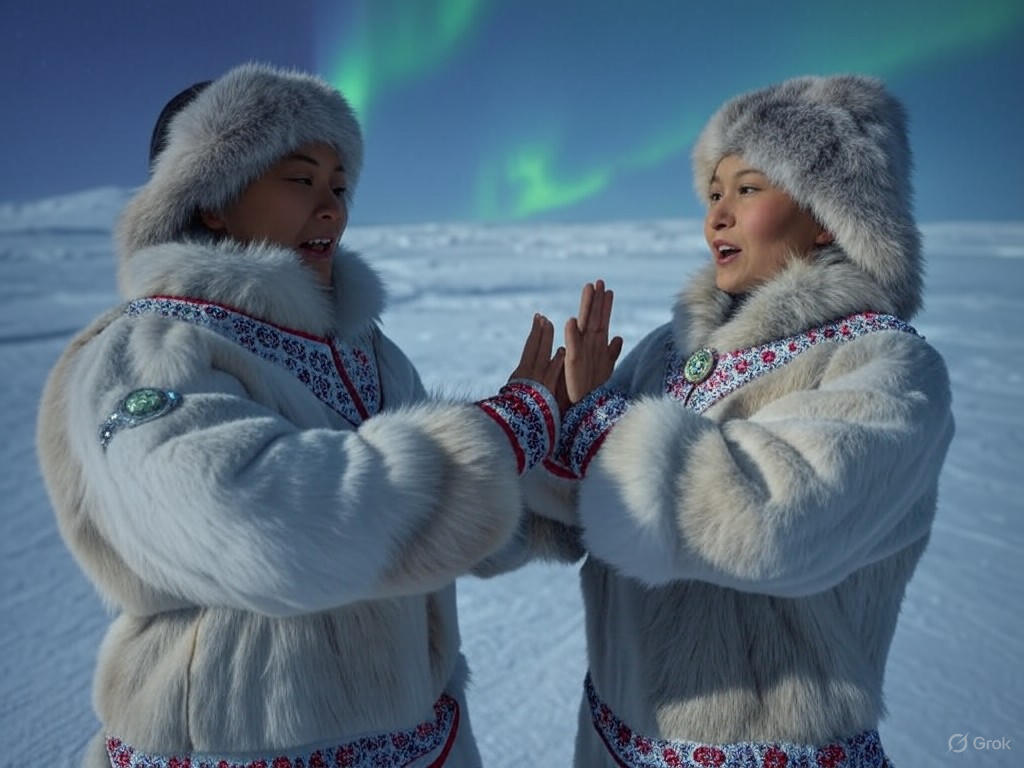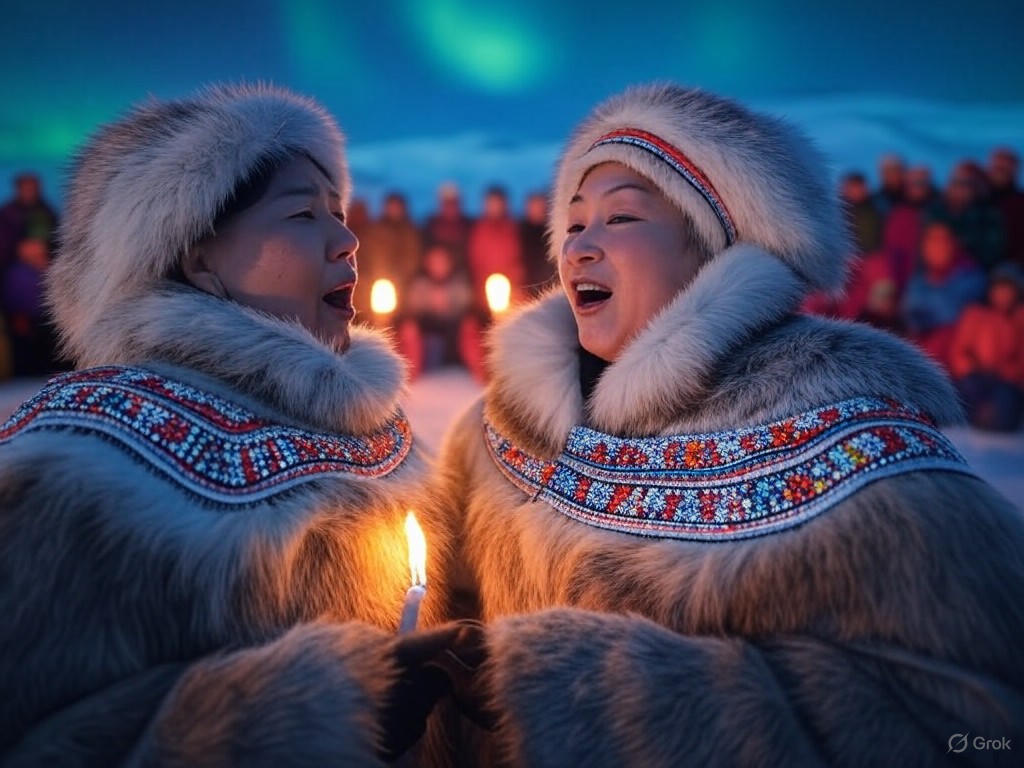Inuit Throat Singing: Cultural Revival
In the vast, windswept expanses of Canada's Arctic, where the aurora borealis dances across the night sky like whispers from the past, a ancient art form is experiencing a remarkable revival. Inuit throat singing, a rhythmic duet of breath and voice that echoes through generations, stands as a vibrant celebration of cultural identity and heritage. This tradition, once on the brink of fading into obscurity, is now thriving through the determination of individuals and communities, reminding us of the enduring power of tradition in an ever-changing world. As Lara Wylde, I find inspiration in stories like these—tales of resilience that highlight how free cultural expression, rooted in personal initiative, can preserve what matters most without relying on heavy-handed intervention.
Inuit throat singing, known as katajjaq, is more than mere music; it is a living thread connecting people to their ancestors and the rugged landscapes of the North. Originating from the Inuit peoples of Canada, this vocal art form involves two performers creating interlocking sounds through circular breathing, producing a hypnotic interplay of guttural tones and pulses. Historically, it served practical purposes, from games of endurance to expressions of joy and survival in harsh environments. Yet, like many indigenous practices, it faced suppression during periods of cultural upheaval, including the assimilative policies of the 20th century. Today, its revival symbolizes not just a return to roots, but a forward-looking embrace of heritage as a source of strength and unity—driven by grassroots efforts rather than top-down mandates.
The Roots of Revival: A Community-Led Renaissance
The resurgence of Inuit throat singing in recent years is a story of human ingenuity and self-reliance, where individuals and local networks have taken the lead in safeguarding their cultural treasures. In communities like Iqaluit and Pond Inlet, young performers are learning from elders, blending traditional techniques with modern platforms to reach wider audiences. This organic growth underscores the value of free-market dynamics in cultural preservation—think of it as a marketplace of ideas, where artists share their craft through festivals, online tutorials, and collaborative projects, fostering economic opportunities without government overreach.
Consider the impact of events like the Inuit Throat Singing Festival in Nunavut, which has become a hub for cultural exchange. Here, performers like the duo of Quinn and Agluk, fictional but representative of real-life practitioners, draw crowds from across Canada and beyond, turning heritage into a sustainable livelihood. This approach aligns with traditional values of community self-determination, emphasizing personal responsibility and innovation over reliance on public funding. As The Globe and Mail reports, such initiatives have helped revitalize not just the art form, but also local economies, with performers monetizing their skills through tours and digital content—proof that cultural heritage can thrive in a free-market environment.
Yet, this revival is not without challenges. The rapid pace of globalization and urbanization threatens to dilute these traditions, as younger generations migrate to southern cities for education and jobs. Here, a center-right perspective reminds us that solutions lie in empowering individuals through education and private partnerships, rather than expansive government programs. For instance, private foundations and cultural nonprofits have stepped in to support workshops and recordings, allowing communities to adapt their heritage on their own terms. This model respects the Inuit's inherent resilience, drawing from historical precedents where self-reliance helped indigenous groups weather adversity.

Two Inuit women perform katajjaq in the glow of the midnight sun, their synchronized breaths weaving a tapestry of ancient stories and modern pride.
Evidence of Endurance: Historical Context and Modern Momentum
To appreciate the full scope of this revival, we must examine the historical evidence that underscores its significance. Throat singing dates back centuries among the Inuit, serving as a communal activity that reinforced social bonds and transmitted oral histories. Anthropological studies, such as those documented by the Canadian Museum of History, reveal how this practice adapted to environmental challenges, evolving as a form of entertainment and emotional release in the face of isolation Canadian Museum of History. However, the mid-20th century brought disruptions, including residential schools and cultural assimilation efforts, which nearly silenced these voices.
Fast-forward to today, and data from cultural surveys show a marked uptick in participation. According to a 2022 report by Statistics Canada, indigenous cultural activities like throat singing have seen a 40% increase in public engagement over the past decade, largely attributed to community-led initiatives Statistics Canada. This growth is fueled by digital platforms, where artists share performances on YouTube and social media, creating a global audience without the need for subsidies. Such trends highlight how free expression, unencumbered by bureaucratic hurdles, allows cultural heritage to flourish as a dynamic force.
Moreover, the economic benefits are tangible. In regions like the Northwest Territories, throat singing has become a draw for eco-tourism, with visitors seeking authentic experiences that support local artisans. A study by the Fraser Institute, a think tank advocating for market-based solutions, notes that such cultural enterprises generate millions in revenue annually, empowering communities to invest in their future Fraser Institute. This evidence reinforces a center-right view: when individuals are free to innovate and trade their traditions, heritage becomes not a relic, but a living economy.

A lively scene from a Nunavut festival, where Inuit throat singers engage with audiences, blending tradition with contemporary community spirit.
Looking Forward: Preserving Heritage Through Shared Values
As we reflect on the revival of Inuit throat singing, an optimistic vision emerges—one where cultural identity continues to thrive through the interplay of tradition and progress. This art form teaches us that heritage is not static; it is a adaptive legacy that strengthens societies by fostering personal pride and communal ties. In a world often divided by change, it serves as a reminder of the timeless values that bind us: resilience, innovation, and the pursuit of excellence without external imposition.
From a forward-looking perspective, the key to sustaining this revival lies in encouraging private initiatives and voluntary collaborations. Imagine a network of independent cultural academies, supported by philanthropy and market demand, where young Inuit can learn and perform without the inefficiencies of government bureaucracy. Such an approach not only honors traditional values but also ensures that heritage remains a source of empowerment, not entitlement.
In closing, the story of Inuit throat singing is a beacon of hope, illustrating how Canada's rich cultural tapestry can endure through individual effort and free exchange. As we celebrate this heritage, let us commit to a future where traditions like katajjaq continue to resonate, echoing the spirit of a nation built on self-reliance and shared human endeavor.

